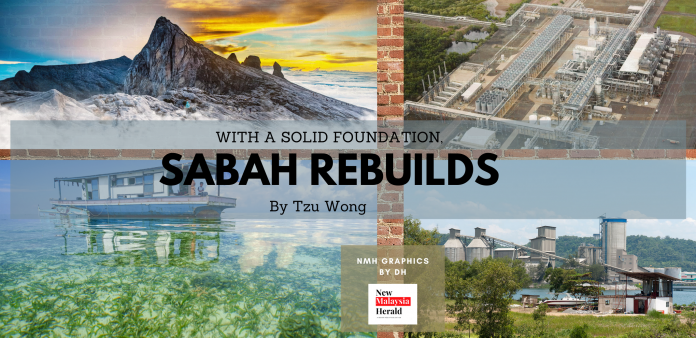Part 3 by Tzu Wong
After the foundations are laid (as spelt out in my earlier two articles here and here) we can then finally start building. This is the fun part, it is something that can get our hands dirty, but this is the thing that I like to do the most. The bending and twisting of the iron bars (the anchor industries), the smell and pouring of cement (the GLCs), the designs and detailing of inner renovations (the SMEs), and right up to the selection of window dressings, furniture, and even the souvenirs (the grassroots economies), all these are similar in terms of economic developments. And when all these are properly set and done, we would then be able to enjoy the fruits of our labor.
- Anchor Industry
Investments in anchor industries are important to an economy, especially for a young and small economy like Sabah. Anchor industries not only act as the nursing role for other smaller industries, but can also serve as a financial safety net for the state government.
Sabah has not seen many initiatives or investments in anchor industry as the locomotive for the state economy since the Berjaya Government back in the early 80s. It is therefore high time for the new state government to speed up investments in the following industries to bring the Sabah economy back on her feet.
A. LNG plant: According to SOGDC (Sabah Oil and Gas Development Corporation Sdn Bhd), Sabah has known reserves of 13.22 tcf (trillion cubic feet) in its territories and many more findings are pending for confirmation. These natural gas reserves are more than enough to justify for a full-fledged LNG refinery plant to be built in Kimanis, Sabah, rather than to send it over to Bintulu, Sarawak, for processing. Spin-off investments from this LNG plant, such as urea plant and other fossil-fuel based industrial products will benefit the state government and state economy at length.
B. Cement plant: The cement industry is a crucial industry in an economy and Sabah is the only major region in Malaysia without a cement plant. Ever since our independence, cement has to be imported and that is why cement prices in Sabah are the highest in the country and is one of the reasons why Sabah property and infrastructure costs are much higher than other parts of the country. There is a clinker plant set up during the Berjaya Government to meet local demands, but the cost is high due to the need for importing clinkers, and thus productions were irregular and sometimes unable to meet the increasing demands in the state. Therefore, investment in a cement plant is urgently required in raw material rich Lahad Datu areas to support the future developments in the state.
C. Food processing industries: Agriculture is one of the main pillars and the backbone of the grassroots economies for Sabah. However, the lack of anchor food processing industries in the state has restricted the diversification of agriculture crops and resulted in a vicious cycle hampering investments in other high-value agricultural crops. Sabah GLCs should take the lead in investments in downstream food processing industries such as extracting and packing of fruit juices, food canning, value-add food processing, and essence extraction for the manufacturing of other premium food products. This will encourage and help elevate the local agriculture sectors to grow from small cottage based industries to commercial based industries.
- Potential Commodities
Many people think of commodities as in minerals. For sure, Sabah has many land-based mineral resources such as copper, gold, nickel, etc, but these are non-renewable natural resources and detrimental to the environment if mining is not done properly. Besides environmental concerns, mining industries are also non-recurring and unsustainable for a small economy like Sabah.
The commodities that we have to focus on should be agricultural-based that are sustainable, applicable in the cottage format, and able to command high value, especially in these trying times. The potential agricultural-based commodities that we can tap into should be able to provide in these three usages – as food, as food & industry-based, and solely for industrial purposes.
A. Food Commodities: This category is referred to mainly tropical fruits and vegetables that can be eaten or can be processed into preserved food and/or food essence products. Pineapple, Mango, Banana, Avocado, Pumpkins, and etc are candidates for this category.
B. Food & industrial-based commodities: This category is referred to those tropical fruits, vegetables, and plants that can be used to process into added-value food products, food supplement products, and food-based industrial products, starfruit plant for fruit and bees farming; duckweeds, moringa tree, and kenaf plants for poultry and livestock farming; and kenaf plants for livestock farming as well as for fiber. Fishery (fishing and aquaculture) can be classified under this category as well.
C. Industrial-based commodities: This is referred to mostly forestry commodities such as Softwood planting (Albizia and Larang) and semi-hardwood (Rubberwood). As consumers in the new era are more and more environmentally-conscious, natural timber products will soon be phased out and banned altogether in the market, hence, proper certified timber plantations will be the answer going forward meeting the demands in the future.
And that’s all folks, solving the economy should not be that complicated or difficult. All we need is a willing heart and knowing where to press the buttons. As long as we are willing to try, we will succeed, it is just that simple. – New Malaysia Herald

New Malaysia Herald publishes articles, comments and posts from various contributors. We always welcome new content and write up. If you would like to contribute please contact us at : editor@newmalaysiaherald.com

Facebook Comments